Job market remains strong
Getty Images
The March jobs report, just released by the Bureau of Labor Statistics, is stronger than expected.
Payroll growth was 228,000. Most economists had predicted a number of about 140,000. The numbers of new payroll jobs in January and February were revised downward to 111,000 and 117,000 respectively, but the 3-month average is 152,000 — very close to what it was for all of 2024. Payroll growth was strongest in health care (54,000) and in leisure and hospitality (43,000).
In the survey of households, the unemployment rate ticked up very modestly to 4.2%, but it stays within the small range of just above 4% where it has been for months. The slight bump in unemployment was more due to a rise in labor force participation that declining employment.
Are Department of Government Efficiency cutbacks in federal government employment, as well as among contractors and grantees, visible yet? Federal employment declined by 4,000, bringing the total over the last two months to 25,000. These numbers surely understate the magnitudes of federal job loss, perhaps because many took severance pay or are appealing their discharges and view themselves as still employed.
Professional services employment also rose by just 3,000. The very small jobs gain in this category might well reflect workers whose contracts or research grants have been cancelled by DOGE.
Overall, this is a quite strong jobs report; the U.S. labor market and economy have been resilient to date, as employment and consumer spending have remained strong. But there is good reason to believe that this month will be an outlier in an otherwise weaker job market this spring and summer.
For one thing, DOGE cutbacks will no doubt be more visible in the coming months. More broadly, consumer sentiment has declined and retail sales growth has weakened, reflecting the uncertainty of customers over where the economy is headed. This, in turn, will likely generate weak or negative job growth in consumer sectors like retail trade and leisure and hospitality in the coming months, as will our new trade war.
The chaos and negative forecasts generated by the large new tariffs imposed earlier this week by President Donald Trump have yet to be felt in the job market. But financial markets have reacted very negatively, with the S&P 500 now down by nearly 12% from its recent peak and likely to continue falling. Other countries are beginning to retaliate against Trump’s tariffs by raising their own, which will weaken employment in export sectors as well as those based on imports whose prices will rise quite substantially. Inflation rates that have stubbornly remained in the vicinity of 3% will likely rise.
Forecasts of an economic slowdown or even recession are rising. Of course, if Congress passes and Trump signs another major tax cut later this year, it will counteract some of the negative effects of DOGE cuts and tariffs. On the other hand, inflation might further increase, as will concern over an ever-rising level of federal debt.
Thus, to say that the economic outlook for 2025 and beyond is uncertain is a great understatement. The road ahead will no doubt be very bumpy for some time. The Federal Reserve faces a challenging economic environment, in which both inflation and economic activity could worsen, creating a dilemma over where to set interest rates. In recent weeks they have been falling, as forecasters predict a weaker economy and investors head to the bond market to find more stability than in stocks (since more investor demand for bonds raises bond prices, which lowers interest rates); future trends are less clear.


